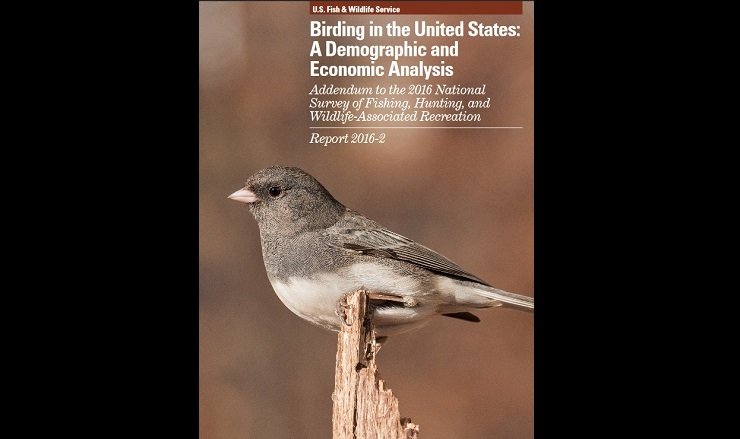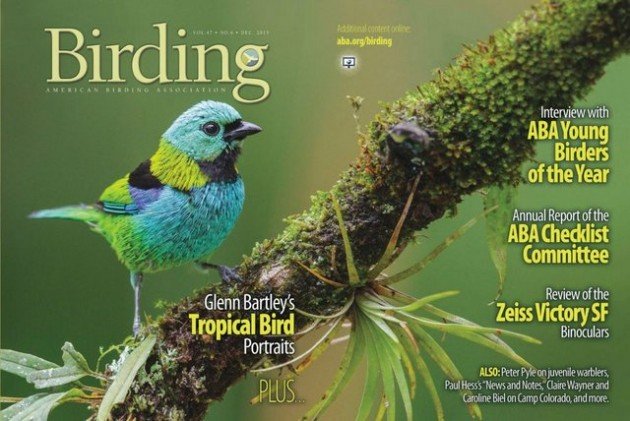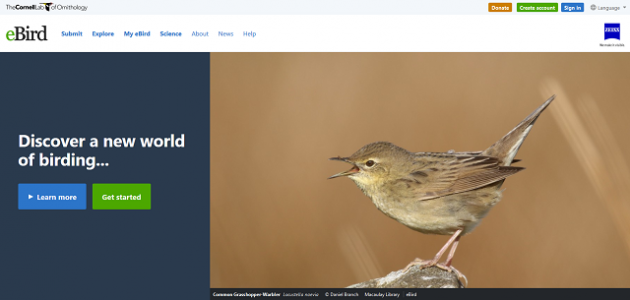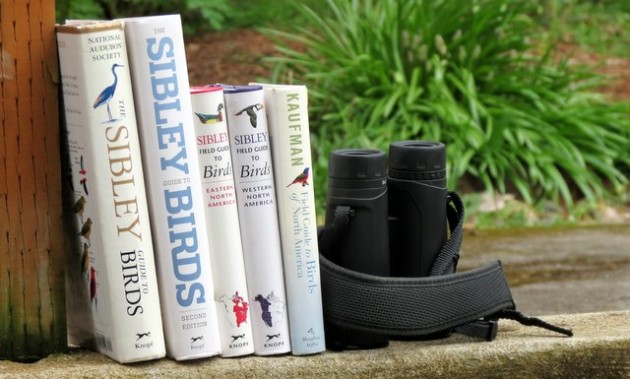
How many birders are there in America? For such a simple question, it turns out there are very few solid estimates. Indeed, there appears to be just one and it is cited repeatedly. Every few years, the U.S. Fish & Wildlife Service (FWS) releases a survey called “Birding in the United States: A Demographic and Economic Analysis.”
The most recent report was issued in December 2019 and it used data from the 2016 National Survey of Fishing, Hunting, and Wildlife-Associated Recreation. The report stated that there were 45 million “birders,” of which 39 million were “around-the-home birders” and 16 million were more active “away-from-home” birders who traveled at least a mile to see birds. Thus, the report stated that 18% of all Americans are “birders.”
Who qualifies as a birder? According to the report:
To be counted as a birder, an individual must have either taken a trip one mile or more from home for the primary purpose of observing birds and/or closely observed or tried to identify birds around the home. Thus, people who happened to notice birds while they were mowing the lawn or picnicking at the beach were not counted as birders.
Based on these numbers, FWS estimated that birder spending on equipment and travel generated nearly $96 billion in total industry output, 782,000 jobs, and $17 billion in tax revenue. That’s a lot of birding. There were similar FWS studies using similar methodologies with similar findings in 2003, 2007, and 2013.
However, I suspect that both FWS figures—45 million birders and 16 million active birders—vastly overstate the number of “birders” as that term would be understood by those in the birding community. Put another way, I believe that the vast majority of the 16 million “active birders” would be quite surprised and a bit perplexed to find themselves so categorized. The challenge is the definition of “birder,” particularly when the underlying survey data was generated for a different purpose.
But even if new or better survey questions could be created, what would the criteria be? Some birders might exclude those who do not at least have a pair of binoculars and a field guide, the ability to identify common local birds, or those who have not traveled to go birding. Others might require a life list or the ability to identify a specific number of species, or some other criteria. And birders would expect that other birders understand at least some of the specialized language of birding and share other characteristics of the community. This is not to suggest that one must bounce about the Pacific Ocean on a pelagic tour to qualify as a birder. But, I think most would agree that driving a mile to walk at the local park and seeing ducks on the pond does not a birder make.
While we cannot realistically conduct another survey with different questions or construct different categories with the FWS data, we can assess its conclusions with other data. Individually, all the indirect measures that follow are imperfect, but collectively they provide some insight.

Organizations: There is a group dedicated to birding, the American Birding Association. In 2016, the ABA was starting an ambitious recruiting drive, to expand its membership from about 12,000. (The figure is from Jeff Gordon’s introduction in the February 2016 issue of Birding.) Of course, there are many birders who are not members of the ABA, but 12,000 is a modest number, even if the ABA has grown substantially since 2016. If 1 in 100 birders was a member of the ABA, that would pencil out to 1.2 million birders. If just 1 in 1,000 was a member, that would result in 12 million birders, still far below the FWS figure of 16 million active birders.
Magazines: There are several magazines dedicated to birding. The USPS requires that all periodicals complete and publish Form 3526 to be eligible for periodical postage rates. That information includes the print run for the most recent issue and the “paid distribution.” Birding reported a paid distribution of approximately 9,300 on its Form 3526 in October 2019. Birdwatching recently reported a paid distribution of about 12,000, and Bird Watcher’s Digest states that its printed magazine “reaches” 25,000 subscribers. However, these figures do not appear to include digital subscriptions, which are likely a significant and increasing number of subscriptions. Again, not all birders subscribe to birding magazines, but even accounting for digital subscriptions, these are very modest numbers.

eBird: Although many birders do not use eBird, it is increasingly popular and many younger birders are eBirders. There are (as of 2020) approximately 565,000 world-wide users of eBird. Of course, many eBirders live outside the U.S., so the American contribution to eBird is lower. This too is a very modest number compared to 16 million active birders. For example, if just 1 in 10 U.S. birders was an eBirder, that would be more than three times the global total of eBirders.

Books: There are two birding essentials, binoculars and a field guide. Binoculars are purchased by many non-birders. However, field guides are primarily purchased by birders but also libraries, universities, and nature-related organizations like museums, wildlife refuges, and Audubon chapters. The number of copies of a book sold is hard to ascertain, as publishers consider sales proprietary. (Rankings on Amazon provide information relative to other books, but do not provide a basis to infer how many copies are sold.) However, at least one source reported that way back in 2002, there were approximately 700,000 copies in print of the Sibley Guide to Birds and 250,000 of Kenn Kaufman’s Field Guide to Birds of North America. Several sources state that there are 2.75 million copies in print of all seven editions of the National Geographic Field Guide to the Birds of North America. Of course, there are many other field guides.
These numbers are substantially higher than ABA membership or magazine subscribers, suggesting a higher number of birders. But if we guesstimate that there are approximately 10 million field guide copies in print, that figure would be approximately 60% of the FWS figure for active birders. That back-of-the-envelope analysis would not account for institutional purchases or the fact that most birders have several field guides. (For example, among others, I have the 1st Edition of Sibley, the 2d Edition, both of the smaller regional versions, plus one for the car.)
Facebook: Another possibility is to look at “likes” for birding-related organizations on Facebook. “Liking” on Facebook is costless and signifies some level of interest in the “liked” subject. Because Facebook is ubiquitous, this data should include many birders, even if the demographics of birding skew older. Once again, not all birders are on Facebook and not all birders on Facebook will “like” birding-related organizations.
Some examples (as of May 2020): David Sibley (~160,000 “likes”), eBird (~75,000), Rockjumper Worldwide Birding Tours (~44,000), American Birding Association (~25,000), 10,000 Birds (~19,000), Field Guides Birding Tours (~15,000), Kaufman Field Guides (~12,500), Biggest Week in American Birding (~10,500), Rio Grande Valley Birding Festival (~8,500), Victor Emanuel Nature Tours (~2,700). There are more, but these seem representative.
More broadly, for bird-related conservation and study, there are: National Audubon Society (~1.4 million), Cornell Lab of Ornithology (~770,000), American Bird Conservancy (~730,000), BirdLife International (~325,000), and the National Wildlife Refuge System (~270,000).
These Facebook “likes” (note that these are global “likes”) further suggest that the number of active birders is much lower than FWS estimates. For example, if just 1% of birders “liked” either eBird or the ABA, that would pencil out to 10 million birders.
Others: There are many birding festivals, including several large and well-attended ones, but attendance numbers for any individual event do not provide much information about the overall number of birders.
There are companies that track traffic on websites, and they are interesting, but seem duplicative of other data. Nonetheless, here are links for the ABA and eBird. The ABA website appears to average somewhere in the neighborhood of 100,000 to 125,000 visits per month.
One could also count followers on Twitter, but those numbers also seem duplicative. Nevertheless, here are two: ABA (about 24,000 followers) and eBird (about 30,000). These numbers are also modest.
I can find no reliable estimates of the numbers of birding-related apps that have been downloaded. However, according to its Project Coordinator, the Merlin app had nearly 1 million active users in the U.S. during the six months that ended in May 2020.
* * * *
Again, all of these indirect measures are imperfect. But they have the advantage of being countable, verifiable, and clearly directed to the birding community. With this additional data, we can broadly evaluate the FWS conclusion that there are 16 million “active” birders.
If you think that birders tend to enjoy birding independently and are strongly disinclined to join birding organizations, subscribe to birding magazines, buy field guides, submit checklists to eBird, or engage in any manner with the birding community online, you might think these numbers support the FWS conclusions.
But if you believe, as I do, that a meaningful percentage of birders are likely to engage in at least some of these activities, you probably believe that the FWS numbers are too high, and likely way too high.
The data suggests to me that there are maybe a million “birders”—people who would not be surprised to be classified as birders. That rough estimate is 40 times the number of people who “like” the ABA on Facebook and double the global users of eBird. But that estimate is admittedly more art than science, depending, as it does, on one’s estimate of what fraction of birders would engage in these countable activities and, more fundamentally, one’s view of who qualifies as a birder.
The point is not that birders are a tiny or insignificant group, but rather that FWS is too broad in its definition of “birder” and/or that the survey questions are not nuanced enough to distinguish birders from non-birders. The demographics of birders (older, wealthier, and more educated than the overall population) and their widespread distribution and passionate commitment means birders are likely desirable consumers (particularly for optics manufacturers and birding tour companies) and a potentially significant political force.
But it seems highly unlikely that there are 16 million active birders, and anyone who attempts to measure the actual or potential impact of birders as a group should use realistic numbers.
Note: This is based on an earlier post that assessed the 2013 version of the FWS survey.














I love this question and your thorough analysis, Jason. I’ve asked the same question many times and always arrive at the conclusion you did.
This is well done and I bet pretty accurate. It all depends on definition of course but in terms of engaging birders it is better to be be focused on real numbers.
Fascinating stuff, especially since the economic impact of birders gets extrapolated from this number. As usual the devil is in the details, or rather, in the definitions. In any case, thanks for updating the piece.
Very interesting. I wonder if the sale of bird feerlders, nestboxes and bird feed would work as a better indicator of “esthetic” bird lovers, in contrast to the more “scientific” ones. This might explain part of the gap between the FWS numbers and yours.